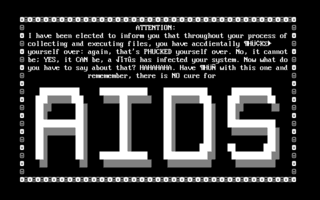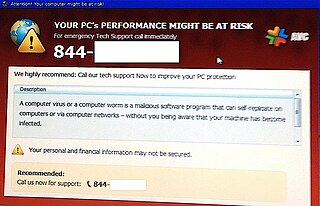
A computer worm is a standalone malware computer program that replicates itself in order to spread to other computers. It often uses a computer network to spread itself, relying on security failures on the target computer to access it. It will use this machine as a host to scan and infect other computers. When these new worm-invaded computers are controlled, the worm will continue to scan and infect other computers using these computers as hosts, and this behaviour will continue. Computer worms use recursive methods to copy themselves without host programs and distribute themselves based on exploiting the advantages of exponential growth, thus controlling and infecting more and more computers in a short time. Worms almost always cause at least some harm to the network, even if only by consuming bandwidth, whereas viruses almost always corrupt or modify files on a targeted computer.
Malware is any software intentionally designed to cause disruption to a computer, server, client, or computer network, leak private information, gain unauthorized access to information or systems, deprive access to information, or which unknowingly interferes with the user's computer security and privacy. Researchers tend to classify malware into one or more sub-types.
In computing terminology, a macro virus is a virus that is written in a macro language: a programming language which is embedded inside a software application. Some applications, such as Microsoft Office, Excel, PowerPoint allow macro programs to be embedded in documents such that the macros are run automatically when the document is opened, and this provides a distinct mechanism by which malicious computer instructions can spread. This is one reason it can be dangerous to open unexpected attachments in e-mails. Many antivirus programs can detect macro viruses; however, the macro virus' behavior can still be difficult to detect.

This timeline of computer viruses and worms presents a chronological timeline of noteworthy computer viruses, computer worms, Trojan horses, similar malware, related research and events.
The Melissa virus is a mass-mailing macro virus released on or around March 26, 1999. It targets Microsoft Word and Outlook-based systems and created considerable network traffic. The virus infects computers via email; the email is titled "Important Message From," followed by the current username. Upon clicking the message, the body reads, "Here's that document you asked for. Don't show anyone else ;)." Attached is a Word document titled "list.doc," containing a list of pornographic sites and accompanying logins for each. It then mass-mails itself to the first fifty people in the user's contact list and disables multiple safeguard features on Microsoft Word and Microsoft Outlook.

Antivirus software, also known as anti-malware, is a computer program used to prevent, detect, and remove malware.
The Sobig Worm was a computer worm that infected millions of Internet-connected, Microsoft Windows computers in August 2003.
The EICAR Anti-Virus Test File or EICAR test file is a computer file that was developed by the European Institute for Computer Antivirus Research (EICAR) and Computer Antivirus Research Organization (CARO) to test the response of computer antivirus (AV) programs. Instead of using real malware, which could cause real damage, this test file allows people to test anti-virus software without having to use a real computer virus.

AIDS is a DOS computer virus which overwrites COM files.
Win32/Simile is a metamorphic computer virus written in assembly language for Microsoft Windows. The virus was released in its most recent version in early March 2002. It was written by the virus writer "Mental Driller". Some of his previous viruses, such as Win95/Drill, have proved very challenging to detect.
ILOVEYOU, sometimes referred to as the Love Bug or Loveletter, was a computer worm that infected over ten million Windows personal computers on and after May 5, 2000. It started spreading as an email message with the subject line "ILOVEYOU" and the attachment "LOVE-LETTER-FOR-YOU.TXT.vbs." At the time, Windows computers often hid the latter file extension by default because it is an extension for a file type that Windows knows, leading unwitting users to think it was a normal text file. Opening the attachment activates the Visual Basic script. First, the worm inflicts damage on the local machine, overwriting random files, then, it copies itself to all addresses in the Windows Address Book used by Microsoft Outlook, allowing it to spread much faster than any other previous email worm.
Jerusalem is a logic bomb DOS virus first detected at Hebrew University of Jerusalem, in October 1987. On infection, the Jerusalem virus becomes memory resident, and then infects every executable file run, except for COMMAND.COM. COM files grow by 1,813 bytes when infected by Jerusalem and are not re-infected. Executable files grow by 1,808 to 1,823 bytes each time they are infected, and are then re-infected each time the files are loaded until they are too large to load into memory. Some .EXE files are infected but do not grow because several overlays follow the genuine .EXE file in the same file. Sometimes .EXE files are incorrectly infected, causing the program to fail to run as soon as it is executed.
Cryptovirology refers to the study of cryptography use in malware, such as ransomware and asymmetric backdoors. Traditionally, cryptography and its applications are defensive in nature, and provide privacy, authentication, and security to users. Cryptovirology employs a twist on cryptography, showing that it can also be used offensively. It can be used to mount extortion based attacks that cause loss of access to information, loss of confidentiality, and information leakage, tasks which cryptography typically prevents.

McAfee VirusScan is an antivirus software created and maintained by McAfee. Originally marketed as a standalone product, it has been bundled with McAfee LiveSafe, McAfee AntiVirus Plus, McAfee Total Protection and McAfee Gamer Security since 2010. McAfee LiveSafe is antivirus protection that defends against viruses, online threats, and ransomware with online and offline protection integrates antivirus, firewall and anti-spyware/anti-ransomware capabilities.
In 2006, British telecom company BSkyB started offering Sky Broadband customers a branded version of VirusScan for free upon broadband modem installation.

A computer virus hoax is a message warning the recipients of a non-existent computer virus threat. The message is usually a chain e-mail that tells the recipients to forward it to everyone they know, but it can also be in the form of a pop-up window.

VirusTotal is a website created by the Spanish security company Hispasec Sistemas. Launched in June 2004, it was acquired by Google in September 2012. The company's ownership switched in January 2018 to Chronicle, a subsidiary of Google.

A computer virus is a type of malware that, when executed, replicates itself by modifying other computer programs and inserting its own code into those programs. If this replication succeeds, the affected areas are then said to be "infected" with a computer virus, a metaphor derived from biological viruses.
Anna Kournikova was a computer virus that spread worldwide on the Internet in February 2001. The virus program was contained in an email attachment, purportedly an image of tennis player Anna Kournikova.
The Stars virus is a computer virus which infects computers running Microsoft Windows. It was named and discovered by Iranian authorities in April 2011. Iran claimed it was used as a tool to commit espionage. Western researchers came to believe it is probably the same thing as the Duqu virus, part of the Stuxnet attack on Iran.
Sality is the classification for a family of malicious software (malware), which infects Microsoft Windows systems files. Sality was first discovered in 2003 and has advanced to become a dynamic, enduring and full-featured form of malicious code. Systems infected with Sality may communicate over a peer-to-peer (P2P) network to form a botnet to relay spam, proxying of communications, exfiltrating sensitive data, compromising web servers and/or coordinating distributed computing tasks to process intensive tasks. Since 2010, certain variants of Sality have also incorporated rootkit functions as part of an ongoing evolution of the malware family. Because of its continued development and capabilities, Sality is considered one of the most complex and formidable forms of malware to date.






